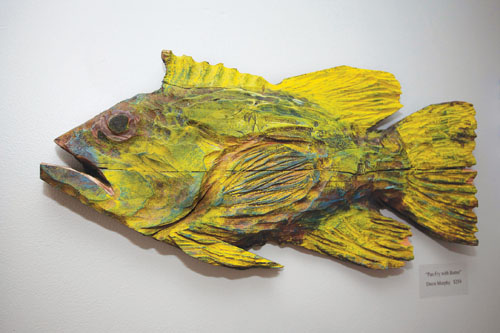Greenport brewery hosts event to help restore eelgrass beds

On the heels of Arbor Day, a Greenport event aimed at adding green to the Earth focused not on planting trees but instead on saving a sea grass.
To bolster eelgrass restoration in Greenport Harbor, Cornell Cooperative Extension partnered with Hops for Habitat, a marine-themed art show at Greenport Harbor Brewing Company, to present a workshop Sunday morning. The public was invited to gather outside the brewery and create eelgrass planting discs by sewing grass shoots into circles cut from burlap. By the workshop’s end, 212 discs were ready for planting.
The area’s eelgrass beds were decimated by a bacterial infection in the 1930s and have been slow to recover because of human development and dredging of navigational waterways, according to John Botos, program assistant for Cornell’s marine meadows project.
“Eelgrass is important to the natural environment, especially around Long Island because it stops erosion,” said Allison Bauser, a junior at Stony Brook University who is double majoring in marine science and coastal environmental studies. “So our nice community beach homes can be here without getting washed away every time we have a storm. It also gives juvenile fish a place to grow without being preyed on by larger predators.”
She joined Mr. Botos and others at the workshop to help create the planting discs.
Last year more than 35,000 discs were assembled through similar efforts, said marine meadows program coordinator Kim Barbour.
“These plants are going right into Greenport Harbor,” she said. “We have a lot of test plots and full-scale restoration sites and the ones there are so successful. We checked it out a couple weeks ago and it’s doing very well so we’d like to continue here in our own backyard.”
Marine meadows program manager Chris Pickerell said ideal planting sites take about two years to vet to make sure conditions are appropriate for the plants to survive. That means generally cool, clear water with good visibility so light can reach the bottom, as well as low nutrient, phytoplankton and macro algae numbers. An absence of crabs is also preferable.
“They’ll actually dig these things up,” Mr. Pickerell said. “Sometimes to hide or look for prey and other times they just seem to be mischievous crabs. We’ve seen that.”
The marine meadows program will hold its next workshop on the South Fork this weekend. North Forkers wanting to aid in eelgrass efforts can attend the area’s next workshop in New Suffolk, hosted by the New Suffolk Waterfront Association, on June 1 between 3:30 and 5:30 p.m.
The night before the Greenport workshop, the Hops for Habitat art show opening sought to raise awareness of the eelgrass problem, and the brewing company’s tasting room was packed with artists and ecologists Ann Vandenburgh, an owner and the brewery’s gallerist, said the show featured local artists, including Cindy Pease Roe, Paul Kreiling and David Murphy. Riverhead aquarium’s head aquarist, Chris Paparro, also attended.
“I felt like it was a very successful event,” Ms. Vandenburgh said. “I think it was an educational experience for all who visited. We learned a lot about how finfish and shellfish are really important to our local industry and how eelgrass can protect them.”
She described the art as “amazing. It was a very eclectic group of art from watercolors to photography, painting and sculptures. There was a wonderful piece submitted by the Oysterponds Elementary School students that was one of the most talked about pieces in the show.”
That piece, “Ten Percent of a Hundred Million,” is a large fish made from plastic objects the students found on the beach. It’s the result of the collaboration between Ms. Roe and students who were learning about the dangerous effects of littering.
The work’s title reflects the amount of plastic that ends up in the sea each year, 10 percent of the hundred million tons of plastic produced annually, Ms. Vandenburgh said.








